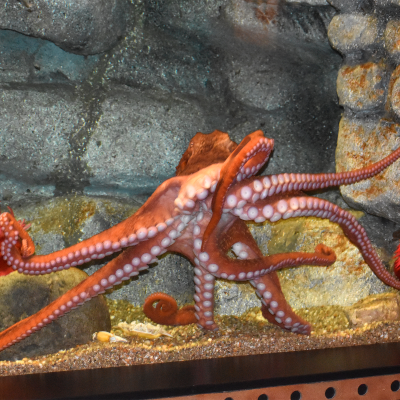About Giant Pacific Octopus
The giant Pacific octopus is the largest species of octopus, with some individuals reaching weights of 600 pounds and an arm span of 9.6 meters.
They are reddish in color but are capable of changing the color of their skin by contracting or expanding tiny pigment-containing granules within cells known as chromatophores, giving them the ability to blend into the environment.
The dorsal mantle of the octopus is sack-shaped and contains the hearts, brains, digestive organs, reproductive organs and two eyes. Their four pairs of arms extend from the base of the mantle.
Octopus are solitary and only leave their den to eat, mate or escape predation. Each pair of arms has up to 280 suckers that are specialized taste and touch receptors that help them detect prey. They are generalist foragers and leave a cache of discarded skeletons (middens) at the entrance to their den.
The octopus’s primary method of defense is camouflage. They can change their color in one-tenth of a second. However, when an octopus needs to escape, they can release a cloud of purple-black ink that acts as a screen, allowing them to use their propulsion to quickly swim away. Their ink is toxic to an octopus, so it isn’t used when they are cornered or as a direct defense. Instead, they will use their arms to attack an opponent, then release ink and swim away.
Giant Pacific Octopus at the Akron Zoo
The giant Pacific octopus lives in Curious Creatures at the Akron Zoo.


